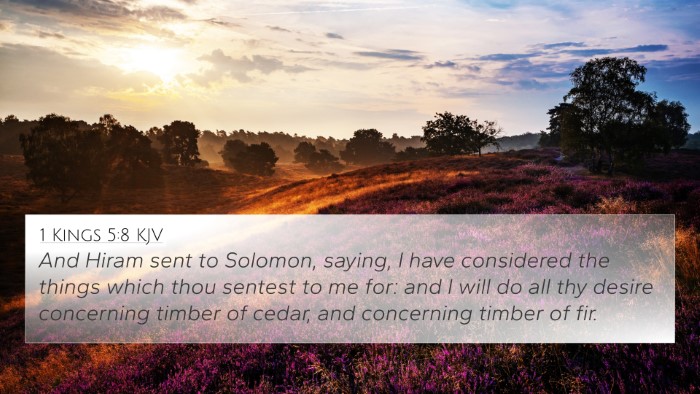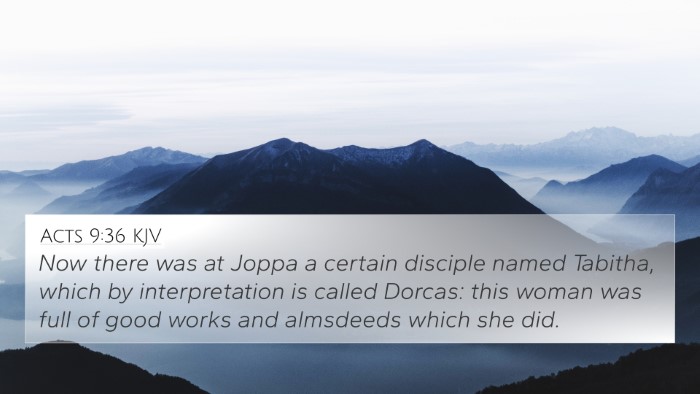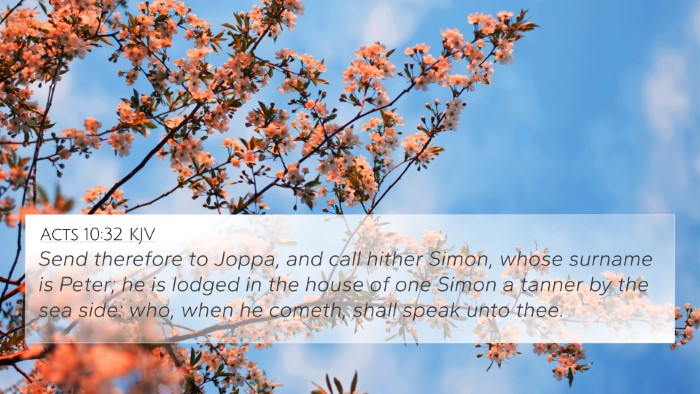Understanding 2 Chronicles 2:16
Verse: "And we will send the wood out of Lebanon, as much as thou shalt need: and we will bring it to thee in floats by sea to Joppa; and thou shalt carry it up to Jerusalem."
Verse Meaning and Context
This verse occurs in the context of King Solomon preparing to build the Temple in Jerusalem. To accomplish this monumental task, he sought the help of Hiram, the king of Tyre. The alliance between Solomon and Hiram was significant, as Tyre was renowned for its skilled craftsmen and abundant cedar wood, both essential for the Temple construction.
- The Importance of Collaboration: The verse highlights the cooperative effort between different nations and leaders for a common purpose—building a house for God.
- Symbolism of Wood: The choice of cedar wood bears symbolic weight, representing strength and durability, qualities desired for a sanctuary dedicated to the Lord.
- Logistical Planning: Solomon's detailed planning in sourcing wood points to the importance of preparation in fulfilling God’s commands.
Commentary Insights
Matthew Henry: Henry emphasizes the necessity of cooperation in divine enterprises, suggesting that Solomon's request for assistance from Hiram showcases the unity needed to fulfill God's work.
Albert Barnes: Barnes mentions that the use of floats to transport the wood signifies a practical approach to overcoming geographical obstacles, pointing to God's provision in our endeavors.
Adam Clarke: Clarke elaborates on the materials used for the Temple, indicating that the finest wood was essential for the dwelling place of God, which reflects the followers’ reverence and commitment to worship.
Cross-Referencing Biblical Texts
To further understand the implications of 2 Chronicles 2:16, we explore various cross-references that relate to the themes of collaboration, preparation, and God’s guidance.
- 1 Kings 5:10-12: This passage provides a parallel account of Solomon's interactions with Hiram regarding the construction of the Temple.
- Isaiah 60:13: This verse relates to the glory of the Lord's house being adorned with the finest materials, indicating the continuity of sacred space.
- Exodus 25:8-9: These verses speak to God's instructions for building a sanctuary, illustrating the divine blueprint Solomon is executing.
- Psalm 127:1: This psalm reinforces the idea that unless the Lord builds the house, the builders labor in vain, emphasizing the necessity of divine assistance.
- 2 Chronicles 3:1: This verse details the actual location chosen for the Temple, showing the fulfillment of Solomon's planning and preparation.
- Nehemiah 2:8: Nehemiah's efforts to rebuild the walls of Jerusalem parallels Solomon's project, demonstrating ongoing themes of restoration and sacred commitment.
- 1 Corinthians 3:9: Here, Paul refers to the Church as God's field and building, linking Old Testament construction themes with the New Testament's understanding of God's dwelling among His people.
Thematic Connections
The themes surrounding 2 Chronicles 2:16 resonate throughout both the Old and New Testaments. The collaborative efforts for building and the necessity for divine guidance can be seen consistently across biblical narratives. Understanding these connections helps enhance our comprehension of scripture as a whole.
Tools for Bible Cross-Referencing
Utilizing various tools for cross-referencing can greatly enhance one's study of scripture. Here are several resources:
- Bible Concordance: A reference tool that lists words found in the Bible, allowing for easy locating of verses.
- Bible Cross-Reference Guide: These guides typically provide lists of related verses, aiding in thematic or topical studies.
- Cross-Reference Bible Study Techniques: Learning how to link verses during study can illuminate new insights and connections.
- Bible Reference Resources: Many study Bibles include margin notes with relevant cross-references for deeper understanding.
Conclusion
In conclusion, 2 Chronicles 2:16 serves as a vital reminder of the collaborative and preparative aspects of fulfilling God's will. The insights from various public domain commentaries coupled with relevant cross-references enrich our understanding of this scripture. As we explore these connections, we become better equipped to comprehend the overarching narrative of God’s redemptive plan throughout the Bible.








